By Catherine Prendergast
The American men do not end their season in London. We know this. No American is currently ranked in the top ten, never mind the top eight. It’s been a terrible year for American men in tennis, frankly, with no American making it into the second week of the US Open: a first since the dawn of time.
So where do the American men end their season if not in London? Lately, with the exception of Quisner, it’s been at the Champaign Challenger, a 50K event held annually in Champaign, Illinois. The names on this challenger’s 2013 initial player acceptance list are familiar: We have veterans Brian Baker, Rajeev Ram, Bobby Reynolds, Robby Ginepri, and Alex Kuznetsov. We have the new crew: Tennys Sandgren, Rhyne Williams, Ryan Harrison, Steve Johnson, Dennis Kudla, Tim Smyczek, and Jack Sock. Everyone has been waiting for this mass of American men to differentiate themselves and give us all a reason to cheer them on.
The Champaign Challenger represents one last chance for them to do just that, to boost their rankings into the next 100. It’s one last chance to rise to the top above the rest. What we have going on in Champaign, then, is something like Custer’s Last Stand—except in this version there are no Indians so the Americans are left shooting at each other.
Where is Champaign, IL, you ask? Exactly here:
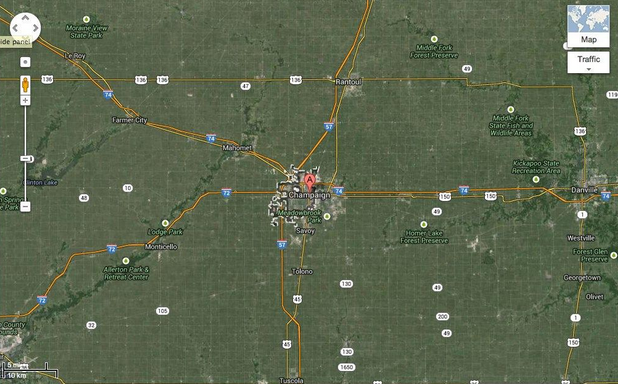
Start driving a car out of Champaign, and you’ll see nothing but corn and soy agribusiness for an hour and a half in any direction. With the possible exception of Binghamton, NY, this is the bleakest stop on the ATP Challenger Tour. Total flyover country. It’s so flat here they say you could watch your dog run away for three days. And if that weren’t enough, the Champaign Challenger is held in grim November, when it’s either in the 40s, windy, and rainy, or in the 30s, windy, and snowing.
Which is probably why Baker, Ginepri, Reynolds, Harrison, Williams, Kudla, and Johnson never show and are replaced by alternates from Zimbabwe and South Africa and other places where they are not slouching toward turkey.
The Americans that do commit are further down the rankings, where the names are less recognizable. A search on the ATP World Tour page for player profiles turns up a lot of missing headshots and a lot of unknowns. As in “Plays: Unknown.” (For the record, ATP, Austin Krajicek is a lefty). A lot of the current Illinois men’s team fill in the qualifying rounds or are Wild Card entrants into the main draw. Few of you have yet heard of them.
In short, the Champaign Challenger of 2013 is a wide open field playing in a wide open field.
But all is not as immediately appears. Especially for a small town, Champaign is as rich in tennis history as it is in arable land. The banners from NCAA championships wave over the bleachers marking regular titles from 1914 to the 2011 win that wrenched the top spot in the Big Ten from Ohio State’s six-year reign. The NCAA championships were hosted here this year on the outdoor courts built by local billionaire Shahid Khan, CEO of the Flex-N-Gate factory in adjacent Urbana, IL (and also owner of the Jaguars. He thought he’d buy himself a football team).
The late David Foster Wallace, perhaps the best American novelist of the last century, wrote quite a bit about tennis, including a short story, “Derivative Sports in Tornado Ally,” about the experience of playing tennis in the Champaign area as a junior. The Champaign Challenger unfolds under the banners of American ATP stand-outs—Amer Delic, Kevin Anderson, Rajeev Ram—who played for the Illini under then coach Craig Tiley. Tiley has long since left, becoming the tournament director of the Australian Open, and subsequently Chief Executive of Tennis Australia. But it was Tiley who started the Challenger here in 1996; he still beams down on the proceedings from a banner of the 2003 NCAA Championship team photo, lending the whole event an air of gravity. The local club players still pass on the bits of advice they learned from “Craig” as they watch.
In short, the people of Champaign know and value their tennis more than you might expect. And when the Challenger comes to town, they come out and sit on possibly the least comfortable bleachers in the world to see the matches. They host the players in their homes. (I overhear one booster say, “We’ve got Rajeev.”) They take days off work to volunteer. They are very fair as crowds go. Except for a very occasional shout out, it’s subdued, whereas when the men’s Illini tennis team play Ohio State, it is rock arena loud in Atkins Tennis Center. (Because let’s face, it: Across the road at the football stadium, there’s nothing to cheer about.)
There are a few other things that make the Champaign Challenger a notable event.
#NoShaveNovember
Unfortunately the Champaign Challenger also coincides with #NoShaveNovember, the initiative that encourages American men to demonstrate their love and concern for each other’s prostates by growing 1970s porn staches. But the locals hate it. Nothing says, “We don’t give a fuck about this crowd” like this hair. I don’t think much more need be said, except that to the great relief of the locals, this year many of the men abstained.
The role of porn stache star was more than ably filled by Tennys Sandgren, who, with his long hair not to mention that “y” in his name, looked like he should be fronting a Lynyrd Skynryd tribute band instead of playing on the tour. Every time he takes the court, the song “Saturday Night Special” starts running through my head. Allegedly, he’s named after his Swedish grandfather, not poet Lord Alfred Tennyson, but still, one wonders if his parents weren’t kicking themselves: “Dear, can you take Tennys to tennis today?” But I digress.
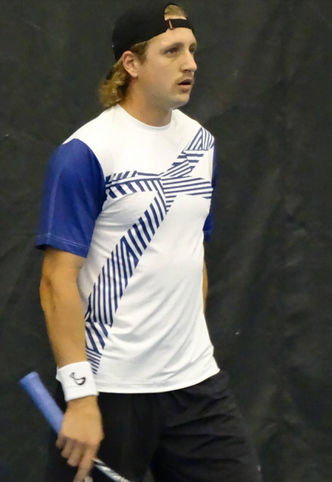
Tennys Sandgren
Athletic DNA
Note above that Sandgren is wearing an Athletic DNA kit. You will never see more Athletic DNA [ADNA] clothing on display in one place than at the Champaign Challenger and the reason in simple: ADNA spreads like a genetically linked trait through the extended Illinois tennis family. The vector is Evan Zeder, a former Illinois player and current ADNA Sales and Sponsorship manager. As I was to learn this week, Sandgren is about to gain honorary Illinois family status through association. I’m about to rename the whole event in my calendar as the “Athletic DNA Open.”
Jimmy Johns
You’ll also see lots of Jimmy Johns subs bags, another local product. The aggressively Republican owner lives in town. I wonder if the players know that these sandwiches are terrible: mostly lettuce and mayonnaise and prone to bacterial hosting. I also wonder, given all the tennis players eat, couldn’t Jimmy cough up a little money to spruce up the event? If you can buy your neighbor’s house to shelter your yacht, Jimmy, perhaps you can spare a dime for all the free advertising you get here.
Sockism
One element of the Champaign Challenger that seems imported is what I will call Sockism: the relentless, and seemingly misguided, boosting of Jack Sock. He’s all over the place. Sock is featured on the poster for the Challenger. But the locals wonder, why? Smyczek beat Sock here last year, Smyczek is seeded first, Smyczek outranks Sock, and Smyczek’s coach is former Illinois player Billy Heiser. Okay Sock is easy to pronounce but is that it?

With those essential items of local knowledge conveyed, on to the rundown of play.
Round of 32: On court 1, Sandgren, unseeded in the draw, currently ranked 235 (high of 209), fresh off beating Ryan Harrison in Knoxville, plays the most convincing tennis of the first round, out-sizing and out-maneuvering the diminutive Canadian Filip Peliwo 6-0, 6-1. Everyone says tennis has become a big man’s game, and Sandgren is one of those big guys. And he’s on a crash course for another big guy: Jack Sock.
Never mind that. From what I’ve seen, I already pick Sandgren to win it all. Sandgren was so solid. It’s hard to explain what exactly is so impressive about his game, because it’s all impressive, presenting no obvious weaknesses.
Up on court 2 is another contrast in size: Denys Molchanov (UKR) and Fritz Wolmarans (RSA) are up against local Illini and Wild Card entrants Ross Guignon and Tim Kopinski (wearing ADNA!). Guignon and Kopinski who have played together so often they finish each other’s sentences like an old married couple. Everything about Guignon is petite: He’s just 5’10”, 140 lbs and looks and sounds like a young Luke Skywalker, complete with the high-pitched voice (“But Uncle Owen!”). Teamed with the only marginally bigger Tim Kopinski (6’, 157 lbs), they are not an immediately imposing presence.
But don’t be fooled. Just a couple of weeks earlier Guignon and Kopinski rose to the semifinals of the ITA National Indoor Championship Final in Flushing Meadow, NY. They have fantastic movement, angles, and touch at the net. It wasn’t enough last Spring where at the NCAA Championships Kopinski and Guignon fell to eventual champions Jarmere Jenkins and Mac Styslinger. The crowd at the Champaign Challenger doesn’t want to see that shit again so they keeping their eyes vigilantly on the match, no one more so than Melissa Kopinski, 2013 All-American and junior on the Illinois women’s team, who watches her twin brother warily.
No worries. Even though Molchanov and Wolmarans have a collected eight inches over Guignon/Kopinski, it’s the first time they’re playing together and it shows. They have no chemistry and no communication so get routined as Guignon and Kopinski land their first professional doubles point, 6-3, 6-4.
Meanwhile, back on court 1, former Illini and two time All American, Dennis Nevolo, originally from Gurnee, IL, currently ranked in the upper 500s, is up against 6th seed Rik DeVoest (RSA).
There is no one this crowd would rather see do well here than Nevolo. He stayed at Illinois during some rough years, keeping the team together and eventually helping them land that Big Ten title in 2011 under current coach Brad Dancer. Nevolo had heart surgery in his junior year to correct a condition that was hampering his fitness. Not that his heart as such is ever in question here in town as he’s known to be a nice guy. Not reputed to be. No, by the locals, he is known to be. The biggest applause of Monday night comes after a sitter from De Voest hands Nevolo the set 6-4. Nevolo plays his ass off with great passing shots and even better defense.
When he faces break point at 2-4 in the second set, a prayer from a nearby spectator, a frequent club player, is whispered: “Stay on it, boy.” The spectator’s head drops as Nevolo saves it, and the head commences slow nodding. I think I see tears poking through squeezed lids.
Nevolo is also known to be a talker, and slightly persnickety. Two foot faults are called on him, and a hindrance. But Nevolo has come a long way in his play since last year and when his opponent donates match point through a double fault, with a shout he books his first win against a top 200 player, 6-4, 7-6(2). The applause is polite, Midwestern, fair. When DeVoest leaves with his gear, a local says, “Hey, good game. I always like seeing you play.” “Thanks, man,” says DeVoest with a smile. The local, who has desperately wanted Nevolo to win turns to me and says, “I like that guy, too.”
The twitterverse could learn much from such people.
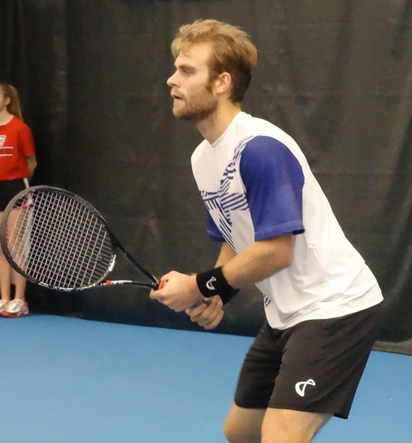
Dennis Nevolo
The next day Tim Smyczek (ADNA!), fresh off winning the Challenger at Knoxville flames out in two sets (5-7, 2-6) to Italian Erik Crepaldi, and Sock moves past a meltdown and saves multiple match points to just squeak past fellow American Bjorn Fratangelo 6-2,4-6,7-6 (8-6), thus maintaining that course for Sandgren.
There aren’t a lot of Europeans in the draw besides Crepaldi. The most distinguishing feature of Jules Marie (FRA), the other European, is his hair. It’s in a “mun,” short for “a man bun.” I regret that I have no good photo, but imagine a top-knot, much like Cindy Lou Who from Whoville. As the people here might say, “That’s different.” He might be saying the same of his surroundings as this looks to be his American debut: His recent events were in Portugal, Sweden, and Luxembourg. You know. Backwaters. At no. 291 in the world, he’s up against one of the Illinois players, Jared Hiltzik, a Wild Card entrant in the draw.
If any of the current Illini stands a chance in the main draw it is Jared Hiltzik. Hiltzik is fresh off the national indoor championships where he made it to the final. His weakness is his volley, but since he plays fantastic defense and has a strong forehand, he doesn’t get to the net all that much. He gets broken at 5-4 in the first set, and the crowd gets edgy. In other words, they remain nearly silent. Hiltzik takes it to a lead in the tiebreak but chokes it away, smashing his racquet into his shoes. Marie calls the trainer for a calf rub after the third game in the second set and breaks Hiltzik. Then Marie serves one underhand (nets it) and obviously tanks the overhand serve (how French) to give Hiltzik the break back. Hiltzik starts moving him around the court. Marie’s mun begins to sag. But Marie does not, staying on task just enough to beat Hiltzik 7-6. 7-5. The crowd is heavily bumming, but is soon to have its revenge.
In the next round, Munhead Marie faces the absolutely biggest guy in the big man game at the moment, Samuel Groth (AUS). Groth possess the fastest recorded serve: 163 miles an hour. One hears mutterings from the players in the stands about it (“Literally unbreakable.” “A real nightmare, idn’t it.”) Local tennis pro Shaun Peterson, who remembers being a ballkid in the first Champaign Challenger in 1996 (Justin Gimelstob, winner of that one) remarks after one of Groth’s bombs, “Dolph Lundgren.” Indeed, Groth looks a lot like Dolph, wielding a racquet instead of a gun.
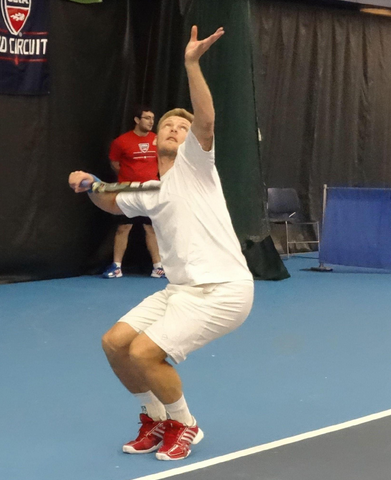
Samuel Groth
Groth takes out Marie handily in Round 2 which sets him up to face Briton David Rice, who he will also handily defeat, buzz-sawing through the draw until the final.
In round 2, Rajeev Ram succumbs in straights to the short, wiry, and preternaturally calm Josh Milton (GBR). They’ve got Ram (Illini alum) on court 1, so court 2 is where the Sock v. Sandgren showdown goes down
Jack Sock looks a good 15 pounds lighter than last year, and he seems to be sweating less, which I’m sure his towel-handlers are grateful for (he is locally legendary for his sweat). He so clearly hates being here. At one point he looks over his head at a guy moving a ladder to fix a speaker, as if to say, Really? The work stops instantly. He is for such gestures not a crowd favorite. As Garrison Keillor once observed, the Midwest does not embrace the standout. Put your head too high above the corn and your neighbors will lop it off.
Sandgren is steady and gets everything he needs to back. Sock gets frustrated and keeps up a muttering monologue through the second set. At one point, almost unbelievably, he does an eerily accurate imitation of Sandgren’s service grunt after he gets aced. Then he walks to the other side of the court and says across the net, “Nice serve.”
Jack Sock is kind of a brat.
In the end Sock goes down to Sandgren, in straights, 7-6 (8), 6-1, and nobody here is too cut up about that. Nobody really even notices because they’re all look at hometown boys HIltzik and Alex Jesse who are in a tight tiebreak with Ball/Polansky on court 1. Hiltzik and Jesse win their match in a third set tiebreak, to the thrill of the crowd, who celebrates for approximately for four seconds.
By Wednesday, then, the top six seeds are out of the singles draw. Thursday night looks like a British invasion crossed with an Illini match. An all Brit doubles affair on court 2 ends with Sean Thornley and David Rice going down (amiably enough) to countrymen Daniel Smethurst and Edward Corrie. Smethurst is having an outstanding tournament, also making the semis in singles. Maybe it’s the Andy Murray effect, maybe it’s the Olympics, perhaps the Royal Baby, but the camaraderie between GBR is adorable and inspiring all tournament long. They believe in each other as much as themselves.
Meanwhile Nevolo and Josh Milton take Court 1. As if taking out Ram weren’t enough, Milton looks to be playing well against Nevolo. Which means he’s a mark for the locals, one of whom describes him as “cagey.” Apparently, however, Milton and Nevolo have become good friends on the tour, so take that, provincialism.
Milton’s well-documented weakness is his serve. Though he plays great defense, Nevolo saves four match points to win in three sets with some aggressive cross-court returns. It’s a great match to watch, one of the best of the week. “I just got a little lucky,” he said afterward. A very nice guy.
Bert and Ernie, uh, Ross Guignon and Tim Kopinski are up next against the Aussies Groth and John Paul (JP) Smith. The Illini boys are way outsized by their opponents, but with Nevolo’s win, the crowd starting to believe. Groth’s name is pronounced fittingly “growth.” He is linebacker big. His partner Smith is also pretty big. Their coach is huge. What are they eating down there? Ask Craig Tiley. They’re his guys now.
Perhaps that’s why the Aussies are not only bigger, they don’t concede any point. They’re fired up. JP Smith gets mad at the ref for a line call and yells, “Balls!” Groth adjusts his. These guys are in total synch.
If you’re looking for a drinking game with Groth, count caught tosses (“Sorry, mate!”). That, or self-adjustments. It’s all working as Groth and Smith prevail in straights.
In the next round, Nevolo will meet Groth, and the crowd is not optimistic. Groth has beaten him before. There’s a gasp when Nevolo deftly returns Groth’s very first serve. The crowd is near ecstatic (they clap briefly) when in the first set Nevolo breaks, and deathly silent when Groth breaks right back. In the end Groth takes the set in the tiebreak. Nevolo comes back weak in set two, getting broken immediately. He can go a little dark, the crowd knows, so they start with the “Come on, D” cheers. Towards the end they have totally lost their carefully curated decorum and are applauding Groth’s unforced errors. But Nevolo can’t catch up from his loss of concentration and Groth prevails, 7-6, 6-4.
I spoke to Nevolo after his match in interview, asking how he prepared for Groth, and he tells the truth: “To be honest, big servers don’t bother me too much.” As Mike Cation, broadcasting the match, noted, Nevolo has the marks of a great returner in the mold of Murray and Agassi. He takes the ball as early as he possibly can. Nevolo said his biggest challenges during the week were adjusting to being the headliner, establishing a routine that would fill the eight hours before match time. He isn’t usually scheduled so late, so he’s unaccustomed to having that kind of pre-match time on his hands. He also tells me that in the pre-season he’ll be working with Smyczek’s coach, and recently also Sandgren’s coach, Billy Heiser.
With that comment, all the missing pieces of the week fall together. The protagonist of this tournament is not on the court: It’s Billy Heiser. Heiser is the reason Smyczek, Sandgren, and Nevolo are here. Several of the current Illini players are at Illinois because they’ve worked with him in the past. He’s got plenty more talent on tap at his academy in the Chicago area for the next generation. If you care about the future of American tennis, you should start following the movements of Heiser closely. Look at the results so far: Smyczek, with whom he travels nearly half the year, was the last American standing in the US Open, and playing well until someone from the stands yelled out, “You’re our last hope!” (Honestly, it was all down hill from there.)Nevolo stands to build on his groundwork this week under Heiser’s guidance. He will wake up Monday to a career high ranking of 493.
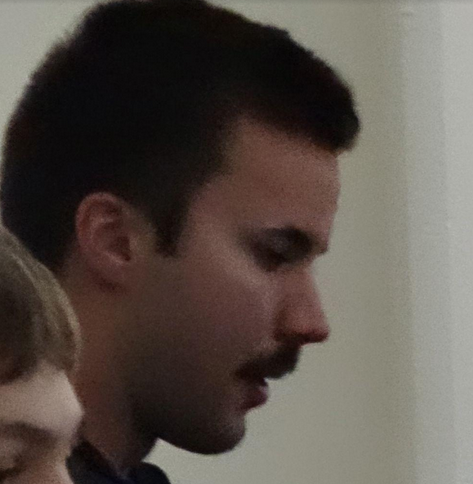
Billy Heiser
And then there’s Sandgren. Sandgren began working with Heiser just before Charlottesville Challenger, a scant few weeks before Champaign. In the end it is the big men who rise to the top, and we get the Sandgren v. Groth final, or what I’m sure will soon be known in the tennis lexicon as a Sandgroth final, with complaints about how power has diminished the game.
In warm ups, Groth warns the ballkids “out wide.” But once play commences, they’re on their own. Champaign fears for its children. A wheelchair user watching from near the corner of the deuce court works the electric controls to back up several feet.
Sandgren looks weary in the first set. Hell, he’s looked weary all week. He does that thing I hate: walking back to his bench while expecting the ball kid to trot right after him with his towel. (Abolish the towel. All it is good for at this point is revealing character in weak moments.)
Groth breaks Sandgren in the seventh game of the match, and Sandgren yells, “Unbelievable!” Predictably, Groth holds easily to win the first set 6-3. So far, it’s a really boring match to watch, the kind that makes you glad it’s not best of five. But there’s some better shot making in the second set, which Sandgren wins, 6-3. So we’re even, on to the third. For all their bigness, both these guys have excellent touch at the net. The last two games and the tiebreak are a killer as both men leave it on the court—Groth, in the form of a smashed racquet. Sandgren, Mr. “Saturday Night Special” wins it on this special Saturday night, 3-6 6-3 7-6. A table is hastily assembled for the awards ceremony: the presentation of the big (only in physical size) $7200 paycheck, and the gifting of four bottles of what is likely the finest Illinois wine. Hearing he is allowed twenty minutes of rest before doubles, Sandgren glares at the organizer, like, Come again? Okay, twenty-two. Take twenty-two minutes.
He comes back in just about twenty-two minutes to join with his partner Austin Krajicek (USA) to face the Adidas-clad Brits, Smethurst and Corrie. Krajicek/Sandgren lose a close first set to Corrie/Smethurst, but come back to bagel them in the second set. Sportsman of the year goes to Edward Corrie who at 4-2 in the match TB confesses to a racquet tip nobody else noticed. Perhaps that was good karma because the tiebreak goes to the two ecstatic and giggly Brits. Hail Britannia. Let’s see more of these guys.
After the doubles trophies are given out, and while the modest crowd remaining begins to shuffle out, the aisle guards and the bleachers are hastily disassembled by the staff, by volunteers, and by the Illini men’s team. Beating pros just days before, Guignon, Kopinski and others are now stacking chairs and folding aisle curtains (it used to be worse—Tiley used to have the team ballboy for the people they lost to in the previous round). It’s all over for another year.
After the match, I asked Sandgren why, when so many on the initial entry list pulled out, he came to Champaign. I believe I said, “Why are you here?” Krajicek, who is nearby, laughs at this question, but Sandgren says evenly, “I wanted to try to do well.” He has a better poker face than Krajicek, apparently:
https://twitter.com/TennysSandgren/statuses/401873668432613376
What a place. Haha.
David Foster Wallace wrote, “The people I know from outside it distill the Midwest into blank flatness, black land and fields of green fronds or five-o’clock stubble.” That’s certainly what I felt about the Champaign before I moved here: I spent most of my early life in New York City and surrounds. But after this week, I conclude that Champaign is the perfect location for the last American Challenger. With its spectacular extremes of bad weather, its rough edges, its lack of meaningful distraction, the place encourages in tennis players what Wallace described as, “an almost Zen-like acceptance of things as they are, on-court.” The proceedings in Champaign remind me of the Last Picture Show, a movie that documents the residents of a windswept and dreary American landscape kept going in the day by day by memories of a more glorious yesteryear. Nothing could better describe American men’s tennis today.
One thing is for sure: All these men should be making much more money for their efforts than they do. A local booster looking down at a first round doubles match turns around to one of the pro coaches and observed that if either of the below teams were to make the final and win, they would take home only 3,100 dollars. “That’s about 1,500 dollars a person. To win it! Time to get a real job, ya think?” The whole town knows this guy, knows he’s an asshole, and maybe even the coach knows it because his response is diplomatic: “Working for the dream.”
Working for the dream means dragging your ass to Champaign, even if it nearly kills you. Sandgren told me he had lost every week of the year but this one. “It’s been a grind, and a heck of a journey for a year,” he remarked. But he saw the guys in front of him pull out of the tournament, and decided, “It looked to be a better opportunity to get some wins.” Pressing his weary body on he played spectacular tennis. As a result, he has achieved a career high of 187. Ladies and gentlemen, a round of applause, please, for the man who broke through in “What a place, haha” Champaign, Illinois.
For 2013, Tennys Sandgren is your last American challenger.
Catherine Prendergast writes about Eastern Europe and tennis. Her book, Buying into English: Language and Investment in the New Capitalist World, chronicles Czechoslovakia’s transition out of communism.




Catherine Prendergast Wow! Most spellbinding piece I have ever read about a tennis tournament! Well done! You are an amazing writer with entertaining insights into time,place and event!! I will wan tto read more of your work My very best Lia Sandgren
Thank you, Lia! I appreciate that high praise. When I write more, you’ll see it here!
PS: Any relation are we to presume?
[…] instance, this amazingly entertaining piece by Catherine Prendergast was just published today. (Confession: oftentimes I’m just waiting […]
Thank you for a very entertaining article – we don’t hear very much about Challenger tourneys. I checked out the first match because Canadian Filip Peliwo was playing – he lost in the first round to Tennys Sandgren. Have to admit I didn’t believe “Tennys” was a real name, so thanks for the explanation. Ended up following the scores to see who won, so really enjoyed learning more about how the tournament unfolded.
The tennis coverage was impressive. But though you may live in Illinois now, your writing makes it clear you still feel the traditional East Coaster’s disdain for all things Midwestern.
You should hear me on the subject of the East Coast. I’m positively merciless.